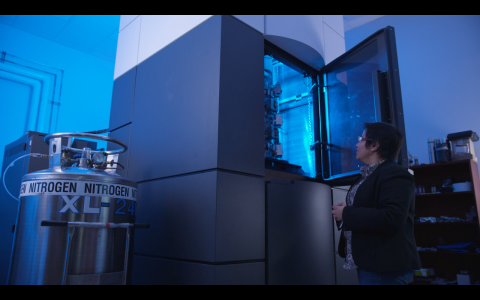
Although most research laboratories at Duke University are shuttered to prevent future transmission of the Covid-19 coronavirus, one of the few to remain open houses a powerful machine that Duke researchers think will be instrumental in developing a vaccine for the virus.
The multimillion-dollar cryo-electron microscope (cryo-EM for short), the Titan Krios, is able to “see” proteins in atomic level detail by taking hundreds of thousands of molecular images of a biological specimen and then classifying and averaging them with powerful software to create a 3D image, and ultimately, a model of the protein.
In the case of the coronavirus, Duke scientist Priyamvada Acharya and her team are using the machine to determine structures of the coronavirus spike protein —the part of the virus that sticks out, attaches with the host, and helps the virus enter into human cells.
“We are using the information to learn, at a basic level, details of how the spike functions, and translate this knowledge for vaccine design,” said Acharya, PhD, an associate professor of surgery in the School of Medicine and director of the Division of Structural Biology at the Duke Human Vaccine Institute.
Better understanding of the structure and function of the spike will also help the team develop molecular hooks to pull out antibodies from the blood of COVID-19 patients, which could be used for vaccine development.
Acharya has been using a similar approach in her quest to develop a vaccine for HIV.
“Cryo-EM helps you rapidly figure out the fine details of intermolecular interactions, thereby giving you the tools to manipulate those interactions to make the best vaccines to trigger the immune system to make protective antibodies,” she said.
“As we move towards the development of a safe and effective vaccine for COVID-19, it’s absolutely imperative that we understand which parts of the virus we need to use for immunization,” said Colin Duckett, vice dean for basic sciences in the School of Medicine. “The right parts will train the immune system to kill virally-infected cells without harmful side effects, but we can only figure that out if we know the active structure of the key proteins, especially the spike protein. That’s where Dr. Acharya’s group comes in. The progress that Dr. Acharya and her team have made so rapidly is nothing short of remarkable.”